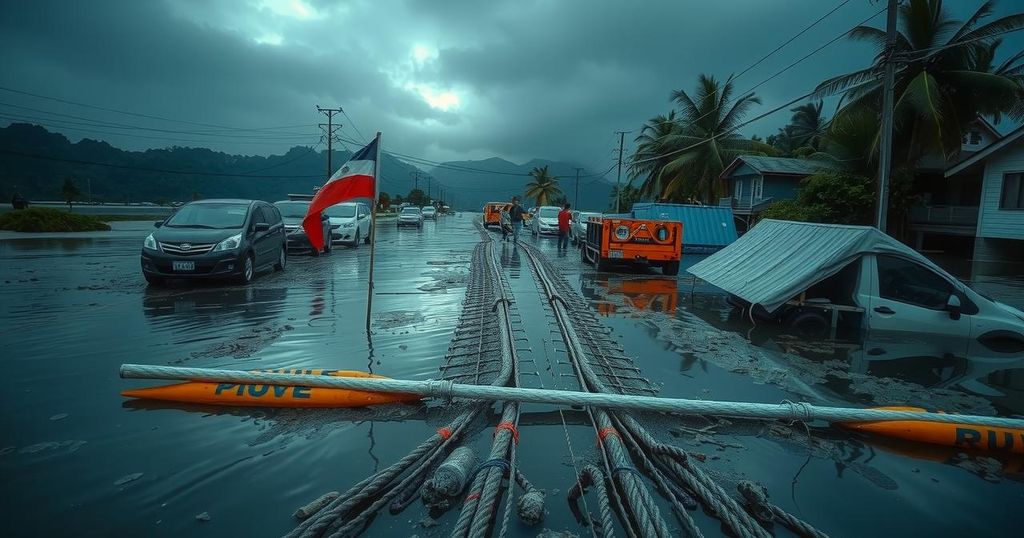Devastating Impact of Tropical Cyclone Kristine Across the Philippines

Tropical cyclone Kristine has led to devastating flooding in the northern Philippines, resulting in over a dozen fatalities and affecting more than 1 million residents. The storm has caused significant damage, with many individuals displaced due to mudslides and heavy rainfall. Government agencies are anticipating extensive impacts, while preparations for future cyclonic events continue amid ongoing rainy conditions in the region.
Tropical cyclone Kristine, locally named, has wrought havoc across the northern regions of the Philippines, resulting in widespread devastation characterized by severe flooding. Tragically, more than a dozen lives have been lost, and several individuals remain unaccounted for. The National Disaster Risk Reduction and Management Council has reported that over one million residents have been adversely affected by the storm, with thousands likely displaced due to mudslides and relentless rainfall. The storm, recognized as Tropical Storm Trami by the Joint Typhoon Warning Center, formed west of Guam before making its landfall on Wednesday in the northern part of the Philippines. The pre-existing heavy rainfall, coupled with the impact of previous cyclones earlier in the month, significantly heightened the region’s susceptibility to flash flooding, as cautioned by government officials. Footage and photographs from the most severely impacted regions depict residents navigating through chest-deep floodwaters, while members of the Coast Guard are engaged in evacuating individuals using boats. Maria Leonor Robredo, the former Vice President of the Philippines, conveyed distressing accounts through social media, stating, “People have been stuck on the roofs of their houses for several hours now. Many of our rescue trucks have stalled due to the floods.” The Philippine Atmospheric, Geophysical and Astronomical Services Administration projected daily rainfall rates to exceed 5 inches in areas where the storm’s bands have been concentrated. Although Manila, the nation’s capital with approximately 14 million residents, is situated at the southern fringe of the storm’s moisture envelope, heavy rainfall is anticipated as Kristine continues its path across the archipelago. Despite forecasts indicating a movement of Kristine’s remnants toward the west and north, continued chances of rainfall loom due to the region’s ongoing rainy season. Historical climatological data shows that Manila typically receives around 100 inches of rain annually, with its dry season spanning winter and spring. While immediate assessments of damages have yet to be released by government agencies, officials anticipate that the destruction will be significant, affecting countless communities with extensive flooding. Furthermore, the national weather service predicts that between 13 to 18 cyclones may be monitored in the area during the 2024 season, with already ten cyclones having impacted the islands in a little over two months. Moreover, a persistent “La Nada” event across the Pacific has likely contributed to the notable inactivity in cyclone activity across the basin and globally. The El Niño-Southern Oscillation is considered to be neutral when the oceanic conditions in the central and eastern Pacific reflect anomalies between 0.5 °C and -0.5 °C, which was observed in early summer. Such neutral conditions profoundly influence the global climate, allowing local weather patterns to dominate regional climates.
Tropical cyclones are significant weather events that can cause extensive damage, particularly in the Philippines, where the archipelago is frequently affected due to its geographical location. Tropical Storm Kristine exemplifies the destructive power of such storms as they interact with pre-existing weather conditions. The combination of prior rainfall and the tropical cyclone led to severe flooding, prompting urgent rescue efforts. Understanding the impact of El Niño and neutral climatic conditions also provides context to the frequency and intensity of cyclones in the region, informing expectations for future weather patterns.
In conclusion, the aftermath of Tropical cyclone Kristine has been devastating for the northern regions of the Philippines, with significant loss of life and extensive flooding affecting over a million residents. The floodwaters have posed unique challenges for rescue efforts, underscoring the vulnerabilities of the population during such natural disasters. As the country braces for potentially more cyclonic activity in the coming months, understanding the climatic conditions and historical data will be vital in preparing for future storms and mitigating their impacts.
Original Source: www.foxweather.com







